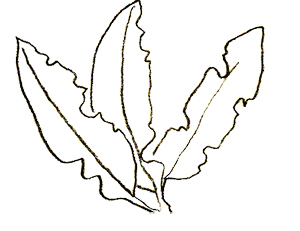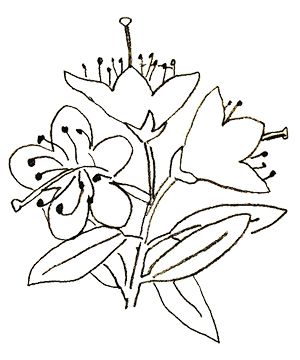Fact Sheet FS1146
Botanically, rhododendrons and azaleas belong to the same genus, Rhododendron, and are affected by the same problems. These plants require well-drained, light, acidic soil and need adequate moisture during the growing months. Winter winds and late afternoon sun can increase environmental stress on rhododendrons and azaleas, so proper site selection is important. Weeds should be hand pulled, not hoed, as azalea and rhododendron roots grow close to the soil surface.
Winter Injury
Winter injury is commonly seen in the landscape and is a result of environmental factors. Temperature fluctuations, late season fertilization, drying winds, late spring frosts, or lack of snow cover can all contribute to winter injury. The most common symptom of winter injury in rhododendrons/azaleas is leaves turning brown. Leaf tips or margins may turn brown, branches may exhibit dieback on their tips, or on the entire branch, or the leaves may roll. Part or all of the plants may be affected. Damage may not be apparent until spring growth begins, or it may appear in late summer. Injured leaves can be picked off. There is no way to reverse the damage so prevention is paramount. Shrubs should be planted in locations protected from the wind or provided with windbreaks. Watering is important in late fall and early winter before the ground is frozen. Plants should be mulched after they are dormant to reduce water loss from the soil and decrease the depth of frost penetration. Loose, coarse mulches (wood chips, shredded bark, oak leaves or pine needles) can be applied to a depth of no more than 3", keeping the mulch a few inches away from the main stem to prevent rodent damage. Mulch that is too deep may lead to severe root damage and death.
Sunburn
Rhododendrons and azaleas are shade plants in their native environments. When planted in full sun, scalding may occur, killing the leaf tissue. Injury, usually to the center portion of the leaf, is unsightly but does not increase in size. Affected leaves may be removed. To prevent this injury, keep plants well watered during hot weather. Plants may have to be moved to a shaded area if shade cannot be provided. The partial shade provided by deciduous trees in both summer and winter protects from sunburn. An eastern or northern exposure is best to prevent sunburn.
Salt Burn
Salt burn occurs in areas of low rainfall, poor drainage, or excess application of fertilizer. Leaf edges may become brown and die. Older leaves are affected first. Damaged leaves will not recover. To prevent salt injury provide adequate water, improve drainage, use fertilizers as recommended on soil tests and avoid exposure of plants to sodium based de-icing salts.
Iron Deficiency-Yellowing of Leaves (Chlorosis)
When rhododendron or azalea leaves turn yellow while the veins remain green, the condition is a result of iron deficiency. It is most commonly seen in plants grown close to masonry walls or where lime has been used in excess. In these situations the soil pH is elevated above the optimal range of 4.5 to 5.5 for these acid-loving plants. A soil test should be used to determine the soil pH. The roots cannot absorb iron from the soil when the pH is too high. Soil acidifiers such as iron sulfate or ammonium sulfate may be used to reduce the pH. Iron chelates may be used as a foliar and/or soil application as a temporary measure to quickly correct the condition. Also excess cultivation or lack of mulch may damage the feeding roots so iron cannot be absorbed.
Dieback
The first symptom of this fungal disease (most commonly Phytophthora) is the appearance of dark brown spots on young leaves, followed by leaf curl. Cankers will develop on the stems, and leaves and stems above the canker will wilt and die. The remainder of the plant will appear healthy. Leaves may turn reddish brown and remain attached to the stem. The stem shrivels. Older branches may be more affected. Wilted or cankered branches should be pruned by cutting a few inches below the canker to where no brown discoloration can be seen in the wood. Discard damaged tissue.
Root and Crown Rots
Various soil-inhabiting fungi known as water molds cause root rot that gets into the stem, blocking water movement. Quickly or slowly, young leaves turn yellow or dull green and wilt, then the entire plant wilts and dies even though the plant is well watered. The leaves remain wilted in the early morning while leaves wilted due to heat or low soil moisture usually recover overnight. If the bark is peeled back close to ground level, the wood will be dark where it is diseased, white where it is healthy.
Rhododendrons and azaleas must be planted in well-drained soil. Use raised beds if necessary. Purchase healthy, disease free plants and wilt resistant varieties. Do not plant rhododendrons or azaleas in contaminated soils for several years after diseased plants have been removed.
Leaf Spots
Leaf spots caused by various fungi may be seen on rhododendrons and azaleas. The color may be yellow, brown or black and the size may range from ¼" to 1" in diameter depending on the causative agent. Inspect older leaves any time during the year and new foliage as it emerges for presence of the disease. Rake away and destroy fallen leaves. Avoid overhead watering that may spread the disease by splashing. These diseases are minor, and affect only the appearance of the plant. Application of a preventative fungicide may protect new foliage.
Petal (Flower) Blight
Mid to late blooming rhododendron flowers may turn to a brown, slimy mass in two or three days during warm wet weather. Infected (brown) flowers remain on the plant longer than normal, presenting an unattractive appearance.
The cause is a fungus whose black spore cases may be seen on infected flowers a month later. Petal blight fungus may over-winter on diseased flower petals and spread the next spring by wind and rain splash. The best control for this problem is complete dead-heading of all flowers, infected and/or healthy. Deadheading will increase the bloom next year. To deadhead rhododendrons simply twist and pull the cluster of seeds located at the terminal of each stem.
Weevils
Black vine weevil (Otiorhynchus sp.) is a common insect pest of rhododendrons. Adults chew on leaves resulting in C-shaped notches as shown in the figure above, while the grubs live in the soil chewing on the crown and roots of the plants. See FS667 Black Vine Weevil for information on the control of this pest. Other weevils infect both rhododendrons and azaleas. The damage done and control measures are similar for all weevils infecting these plants.
Lacebugs
When the upper surface of rhododendrons or azalea leaves have a graying mottled appearance, there is probably a heavy infestation of lacebugs, Stephanitis sp. Lacebugs feed by sucking chlorophyll from the leaves of many plants. These insects may be seen on the lower surface of a leaf. The adults are 1/8" long, flattened, and dark brown or black. Their lace-like wings are held over their backs. The young are dark and may look spiny. Varnish-like spots of excrement are usually seen on leaf surfaces. The lacebug overwinters as eggs in the upper leaf surface. There may be several generations each year. The lacebug problem is most often seen on azaleas stressed by being grown in full sun. Contact your local county extension office for treatment methods.
Leafminer
Azalea leaf miner, (Gracillaria azaleella) or leaf roller damage begins shortly after azaleas bloom as miners eat near the tip or margin of the leaf. The larvae soon emerge and roll up the tip or margin of the leaf and continue feeding. Control measures for lacebug also control leaf miner.
Mites
Mites, like lacebugs, feed on the lower surface of leaves by sucking sap from the leaf. This feeding causes the upper surface to loose color, becoming speckled, gray-green, brown or bronze. If mites are suspected, shake the leaves over a piece of white paper and look for small spots on the paper. If the spots of the paper begin to crawl, they are mites. Mites can be removed by a blast of water from the garden hose.
Scale
Scale insects feed on bark or leaves, producing red or yellow spotting on the leaf or bark of twigs. Scale insects appear as small raised bumps on the twig or leaf. Scale produces a waxy coating that makes them difficult to kill. Small infestations may be scraped off and discarded.
Rhododendron Borers and Rhododendron Stem Borers
Rhododendron borer larvae develop and feed inside the plant stem resulting in wilt. Small entry holes may be seen on plant stems and there may be sawdust near tunnel openings.
Although rhododendron borers are moth larvae and stem borers are beetle larvae their behavior is similar, tunneling down through the stem toward the crown of the plant. This tunneling can kill large branches. Mechanical control for both borers is the same. Cut off the infected branch below the end of the tunnel to include the borer; destroy the branch.
Failure to Flower
While rhododendrons and azaleas grow well in dappled shade they must have adequate light for flower bud formation. Sometimes plants must be moved, trees removed or lower tree limbs removed to gain optimal light. A soil test may indicate the need for phosphorus fertilizer. Apply as directed by the soil test to stimulate flowering.
February 2011
Copyright © 2025 Rutgers, The State University of New Jersey. All rights reserved.
For more information: njaes.rutgers.edu.
Cooperating Agencies: Rutgers, The State University of New Jersey, U.S. Department of Agriculture, and Boards of County Commissioners. Rutgers Cooperative Extension, a unit of the Rutgers New Jersey Agricultural Experiment Station, is an equal opportunity program provider and employer.



